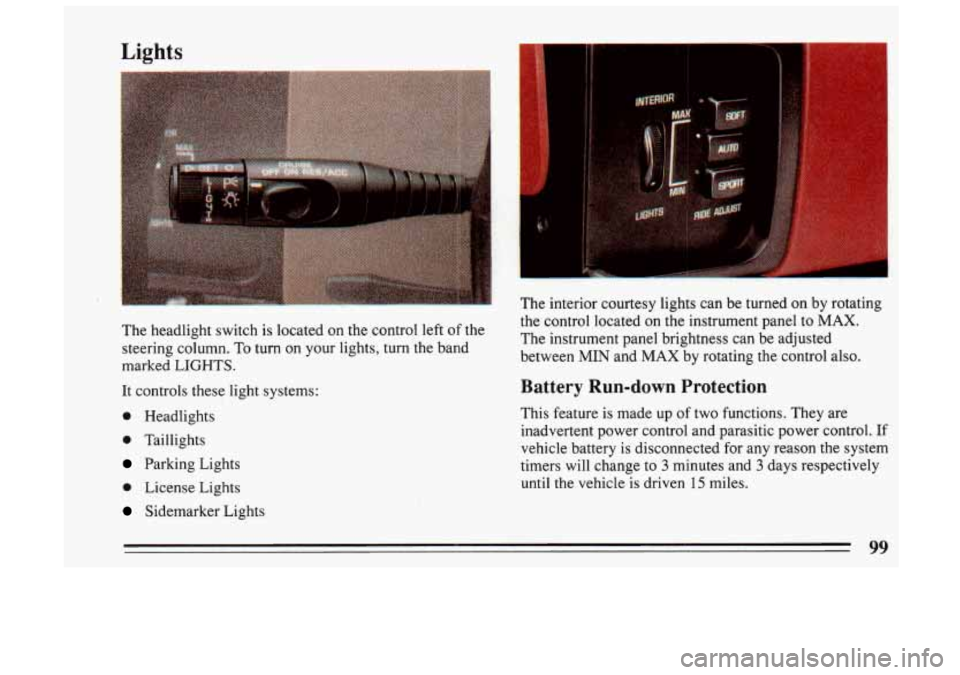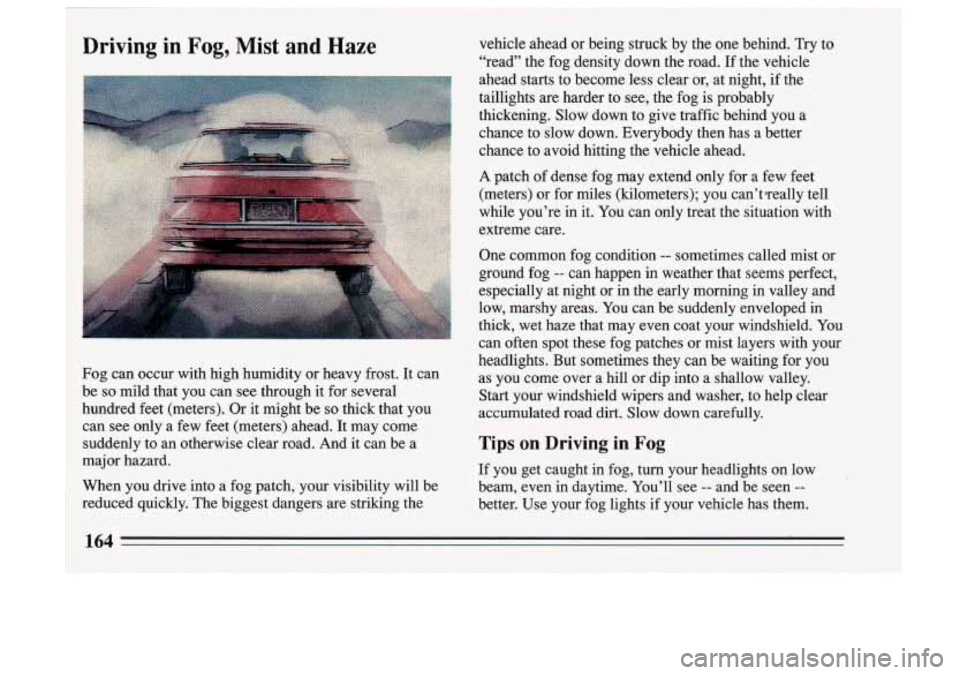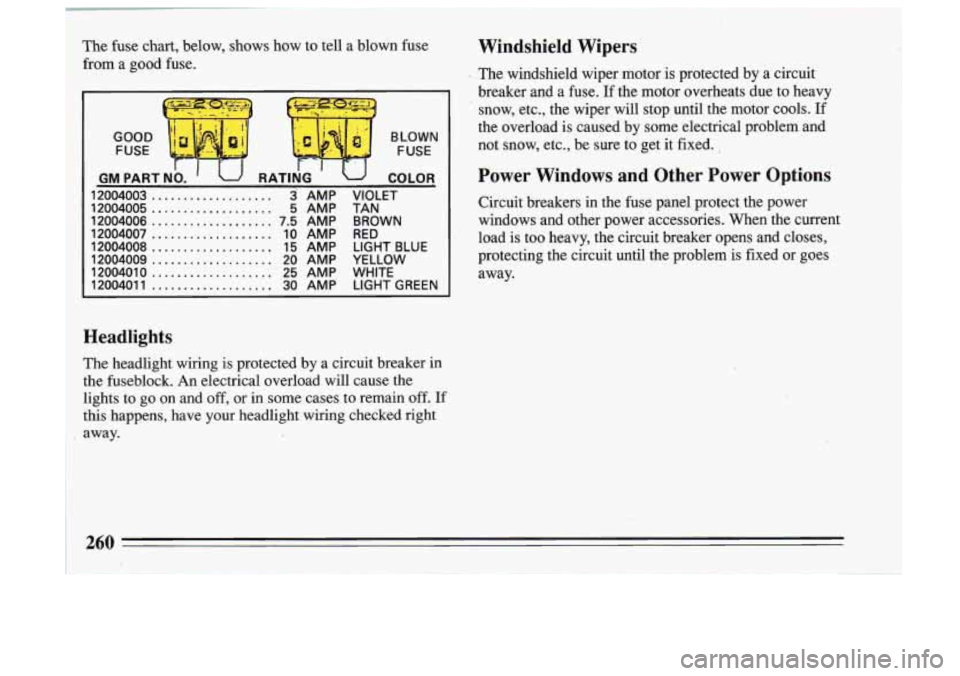headlights BUICK SKYLARK 1993 Owners Manual
[x] Cancel search | Manufacturer: BUICK, Model Year: 1993, Model line: SKYLARK, Model: BUICK SKYLARK 1993Pages: 306, PDF Size: 15.84 MB
Page 91 of 306

Ihrn Signal tCONSS Chime
A chime will sound if your turn signal is left on after
having gone
3/4 of a mile, to remind you to turn your
signal
off.
Operation of Lights
Although your vehicle’s lighting system (headlights,
parking lights, fog lamps, side.marker lights and
taillights) meet all applicable federal lighting
requirements, certain states and provinces may apply their own lighting regulations that may require special
attention before you operate these lights. For example,
some jurisdictions may require that you operate your
lower beam lights with fog lamps at all times, or that
headlights be turned on whenever you must use your
windshield wipers. In addition, most jurisdictions
prohibit driving solely with parking lights, especially at
dawn or dusk. It
is recommended that you check with
you own state or provincial highway authority for
applicable lighting regulations.
Headlight High-Low Beam
To change the headlights
from low beam to high or
high to low, pull the turn
signal lever all the way
toward you. Then release it.
When the high beams are
on, this blue light on the
instrument panel also will
be on.
Flash-To-Pass Feature
It lets you use your high beam headlights to signal a driver in front of you that you want to pass. It works
even
if your headlights are off.
To use it, pull the multifunction lever toward you a little
(but not
so far that you hear a click).
If your headlights are off Your high beam headlights
will
turn on. They’ll stay on as long as you hold the
lever there. Release the lever to turn them
off.
90
I
Page 92 of 306

If your headlights are on, but on low beam: The
system works normally. Just pull the lever until it clicks.
Your headlights will shift to high beam and stay there.
To return to low beam, just pull the lever toward you.
Windshield Wipers
You control the windshield wipers by moving the lever
marked
“WIPER.”
For a single wiping cycle, move the lever down to
“MIST.” Hold it down until the wipers start, then let go.
The wipers will stop after one cycle. If you want more
cycles, hold the lever down to “MIST” longer.
i
For steady wiping at low speed, move the lever to the
“LOW’ position. For high speed wiping, move the lever
further, up to “HIGH” To stop the wipers, move the
lever to “OFF.”
Low Speed Delay Wipers (Option)
You can set the wiper speed for a long or short delay
between wipes. This can be very useful in light rain or
snow. Move the lever to DELAY then, turn the band to
choose the amount of delay.
I A CAUTION:
Damaged wiper blades may prevent you from
seeing well enough
in a storm to drive safely. To
avoid damage, be sure to clear ice and snow
from the wiper blades before using them.
If
they’re frozen to the windshield, carefully loosen
or thaw them.
If your blades do become
damaged, get new blades or blade inserts.
Page 100 of 306

Lights
The headlight switch is located on the control left of the
steering column. To turn on your lights, turn the band
marked LIGHTS.
It controls these light systems:
0 Headlights
0 Taillights
Parking Lights
0 License Lights
Sidemarker Lights The interior courtesy lights can be turned on by rotating
the control located
on the instrument panel
to MAX.
The instrument panel brightness can be adjusted
between MIN and MAX by rotating the control also.
Battery Run-down Protection
This feature is made up of two functions. They are
inadvertent power control and parasitic power control. If
vehicle battery is disconnected for any reason the system
timers will change to
3 minutes and 3 days respectively
until the vehicle is driven 15 miles.
77
Page 101 of 306

Headlights Reminder Light (Canada Only)
If your vehicle was first sold, when new, in Canada, this
light will
go on at night to remind you to turn on the
headlights.
Daytime Running Lights (Canada Only)
The Canadian Federal Government has decided that
“Daytime Running Lights” (DRL) are
a useful feature,
in that DRL can make your vehicle more visible to
pedestrians and other drivers during daylight hours.
DRL are required on
new vehicles sold in Canada.
Your DRL work with
a light sensor on top of the
instrument panel. Don’t cover it up.
The high beam headlights will come on at reduced
brightness in daylight when:
The ignition is on
The headlight switch is off, and
The parking brake is released.
At night, the headlights reminder light on the instrument
panel will come on to remind
you to turn on the
headlights. When
you turn on your headlights, the DRL
will switch
off and the exterior lights will come on.
When
you turn off the headlights, the exterior lights will
go out and the high beams will change to the reduced
brightness of DRL again. Of course, you may still turn on the headlights
or flash to pass any time you need to.
Page 160 of 306

vehicle is skidding. Learn to recognize warning clues --
such as enough water, ice or packed snow on the road to
make a “mirrored surface”
-- and slow down when you
have any doubt.
Remember: Any anti-lock braking system (ABS) helps avoid only the braking skid. Steer the way you want to
go.
Driving at Night
Night driving is more dangerous than day driving. One
reason is that some drivers are likely to be impaired
--
by alcohol or drugs, with night vision problems, or by
fatigue.
Here are some tips on night driving.
0
0 0
0
0 Drive defensively. Remember, this is the most
dangerous time. Don’t drink and drive. (See “Drunken Driving” in
the Index for more
on this problem.)
Adjust your inside rearview mirror to reduce the glare from headlights behind you.
Since you can’t see as well, you may need to slow
down and keep more space between you and other vehicles. It’s hard to tell how fast the vehicle ahead
is going just by looking at its taillights.
Slow down, especially on higher speed roads.
Your
headlights can light up only’s0 much road ahead.
In remote areas, watch for animals.
If you’re tired, pull
off the road in a safe place and
rest.
Page 161 of 306

Avoid staring directly into the approaching lights. If
there is a line of opposing traffic, make occasional
glances over the line of headlights to make certain that
one of the vehicles isn’t starting to move into your lane.
Once you are past the bright lights, give your eyes time
to readjust before resuming speed.
High Beams
If the vehicle approaching you has its high beams on,
signal by flicking yours to high and then back to low
beam. This is the usual signal to lower the headlight
beams. If the other driver still doesn’t lower the beams,
resist the temptation to put your high beams on. This
only makes two half-blinded drivers.
On
a freeway, use your high beams only in remote areas
where you won’t impair approaching drivers. In some
places, like cities, using high beams is illegal.
I
Night Vision
No one can see as well at night as in the daytime. But as
we get older these differences increase. A 50-year-old
driver may require
at least twice as much light to see the
same thing at night as a 20-year-old.
What you do in the daytime can also affect your night
vision. For example,
if you spend the day @ bright
sunshine you are wise to wear sunglasses. ,Your eyes will
have less trouble adjusting to night.
But
if you’re driving, don’t wear sunglasses at night.
They may cut down on glare from headlights, but they
also make a lot of things invisible that should remain
visible
- such as parked cars, obstacles, pedestrians, or
even trains blocking railway crossings. You may want to
put on your sunglasses after
you have pulled into a
brightly-lighted service or refreshment area. Eyes
shielded from that glare may adjust more quickly to
darkness back on the road: But be sure to remove your
sunglasses before you leave the service area.
You can be temporarily blinded by approaching lights.
It can take a second or two, or even several seconds, for
your eyes to readjust to the dark. When you are faced
with severe glare (as from a driver who doesn’t lower
the high beams, or
a vehicle with misaimed headlights),
slow down a little.
..
When you follow another vehicle on a freeway or
highway, use low beams. True, most vehicles now have
day-night mirrors that enable the driver to reduce glare. But outside mirrors are not
of this type and. rh beams
from behind can bother the driver ahead.
160
Page 162 of 306

A. Few ,More Night Driving Suggestions Driving in the Rain
Keep your eyes moving; that way, it’s easier to pick out
dimly lighted objects.
i
Just as your headlights should be checked regularly for
Rain and wet roads can mean driving trouble. On a wet
proper aim,
so should your eyes be examined regularly. road you can’t stop, accelerate or turn as well because
Some drivers suffer from night blindness
-- the inability
your tire-to-road traction isn’t as good as on dry roads.
to see in dim light
-- and aren’t even aware of it. And, if your tires don’t have much tread left, you’ll get
even less traction.
It’s always wise to go slower and be cautious
if rain
starts to fall while
you are driving. The surface may get
P 161
Page 164 of 306

A CAUTION:
Wet brakes can cause accidents. The: ton’t
work well in
a quick stop and may cause pulling
to one side. You could lose control of the vehicle.
After driving through a large puddle of water or
car wash, apply your brake pedal ligh rtil
your brakes work normally.
Hydroplaning
Hydroplaning is dangerous. So much water can build up
under your tires that they can actually ride on the water.
This can happen if the road is wet enough and you’re
going fast enough. When your vehicle is hydroplaning,
it has little or no contact with the road.
You might not be aware of hydroplaning. You could drive
along for some time without realizing your tires aren’t in
constant contact with the road. -You could find out the
hard way: when you have to slow, turn, move out to,pass
-- or if you get hit by a gust of wind. You could suddenly
fiid yourself out of control.
Hydroplaning doesn’t happen often. But it can if your
tires haven’t much tread or if the pressure in ?ne or more
is low. It can happen
if a lot of water is standing on the road. If you can
see reflections from trees, telephone
poles, or other vehicles, and raindrops “dimple” the water’s surface, there could
be hydroplaning.
Hydroplaning usually happens at higher speeds. There
just isn’t a hard and fast rule about hydroplaning. The
best advice is to
slow down when it is raining, and be
careful.
Some Other Rainy Weather Tips
0 Turn on your headlights -- not just your parang
lights
-- to help make you more visible to others.
0 Look for hard-to-see vehicles coming from behind.
You may want to use your headlights even in
daytime if it’s raining hard.
0 Besides slowing down, allow some extra following
distance. And be especially careful when you pass
another vehicle. Allow yourself more clear room
ahead, and
be prepared to have your view restricted
by road spray.
If the road spray is so heavy you are
actually blinded, drop back. Don’t pass until
conditions improve. Going more slowly is better
than having an accident.
Use your defogger if it helps.
Have good tires with proper tread depth. (See “Tires” in the Index.)
163
Page 165 of 306

Driving in Fog, Mist and Haze
Fog can occur with high humidity or heavy frost. It can
be
so mild that you can see through it for several
hundred feet (meters). Or it might be
so thick that you
can see only a few feet (meters) ahead. It may come
suddenly to an otherwise clear road. And it can be a
major hazard.
When you drive into a fog patch, your visibility will be
reduced quickly. The biggest dangers are striking the vehicle ahead or being struck by the one behind. Try
to
“read” the fog density down the road. If the vehicle
ahead starts to become less clear or, at night,
if the
taillights are harder to see, the fog is probably
thickening. Slow down to give traffic behind you a chance to slow down. Everybody then has a better
chance to avoid hitting the vehicle ahead.
A patch of dense fog may extend only for a few feet
(meters) or for miles (kilometers); you can’tyeally tell
while you’re in it. You can only treat the situation with
extreme care.
One common fog condition
-- sometimes called mist or
ground fog
-- can happen in weather that seems perfect,
especially at night or in the early morning in valley and
low, marshy areas. You can be suddenly enveloped
in
thick, wet haze that may even coat your windshield. You
can often spot these fog patches or mist layers with your
headlights. But sometimes they can be waiting for you
as you come over a hill or dip into a shallow valley.
Start your windshield wipers and washer, to help clear
accumulated road dirt. Slow down carefully.
Tips on Driving in Fog
If you get caught in fog, turn your headlights on low
beam, even in daytime. You’ll see
-- and be seen --
better. Use your fog lights if your vehicle has them.
Page 261 of 306

The fuse chart, below, shows how to tell a blown fuse
from
.. a good fuse.
GOOD 1
I FUSE FUSE
BLOWN
' ' u RATING GM PART NO.
12004003 ................... 3 AMP VIOLET
12004006
................... 7.5 AM.P BROWN
12004007
................... 10 AMP RED
12004008
................... 15 AMP LIGHT BLUE
12004009
................... 20 AMP YELLOW
12004010
................... 25 AMP WHITE
12004011
................... 30 AMP LIGHT GREEN
r- -tu COLOR
12004005 ................... 5 -AMP TAN
Headlights
The headlight wiring is protected by a circuit breaker in
the fuseblock. An electrical overload will cause the
lights to go on and
off, or in some cases to remain off. If
this happens, have your headlight wiring checked right
away.
Windshield Wipers
. The windshield wiper motor is protected by a circuit
breaker and a fuse. If the motor overheats due to heavy
snow, etc., the wiper will stop until the motor cools.
If
the overload is caused by some electrical problem and
not snow, etc., be sure to get
it fixed. ,
Power Windows and Other Power Options
Circuit breakers in the fuse panel protect the power
windows and other power accessories. When the current
load is too heavy, the circuit breaker opens and closes,
protecting the circuit until the problem is fixed or goes
away.
260
I